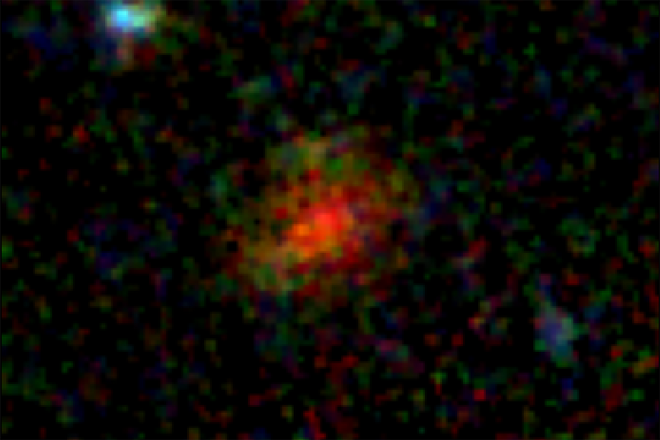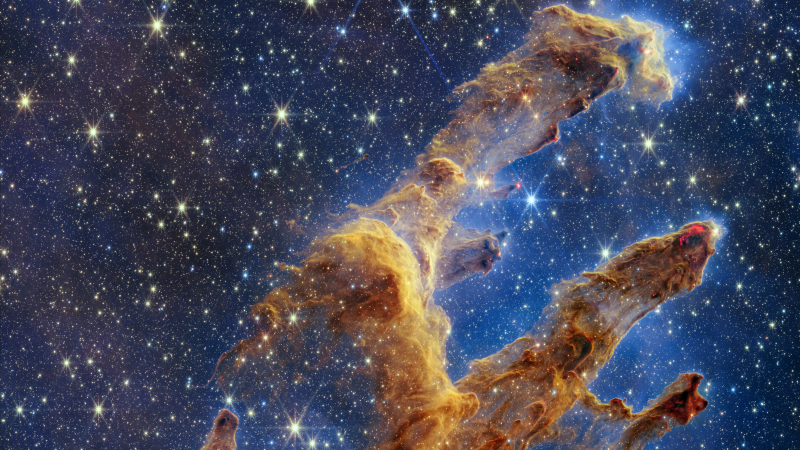Ancient 'ghost galaxy' shrouded in dust detected by NASA: What makes this 'monster' special

Grainy and obscured, a recent image of an ancient galaxy may not exactly be eye-catching.
Those accustomed to seeing stunning photos of the cosmos and faraway galaxies such as those captured by NASA's James Webb Space Telescope or the European Space Agency's Euclid may be disappointed.
But what the seemingly blurry image lacks in visual grandeur, it more than makes up for in substance. That's because the photo – captured by none other than the Webb telescope – spotlights a galaxy so old that the astronomers who located it say it existed just 900 million years after the Big Bang.
For those keeping track, that's eons and eons before our own solar system came into form 4.5 billion years ago.
Shrouded in dust, the perplexing star-forming galaxy has proven elusive to astronomers after Webb's predecessor, the Hubble Space Telescope, once faintly detected it. Once thought to be a rarity, a team of scientists said their recent research suggests such so-called "ghost galaxies" could be up to 10 times as common as previously believed.
The team's findings were published in October in the Astrophysical Journal and announced Monday in a press release that included the hazy photo.
Artemis missions:Here's why NASA's mission to put humans back on the moon likely won't happen on time
Ghost galaxy is 'a real monster'
The image of the galaxy, dubbed AzTECC71, may look like little more than a reddish blob, but its discovery left the team of astronomers almost giddy with excitement.
Previous attempts by NASA's Hubble telescope to seek out phantom galaxies veiled in dust like AzTECC71 proved difficult. Much of the light from its stars is absorbed by a veil of dust and then re-emitted at redder (or longer) wavelengths, which are difficult for older, less advanced telescopes to detect.
In fact, astronomers sometimes refer to these ghostly groupings as "Hubble dark galaxies,” since their low invisibility means they have been difficult to see.
“That means our understanding of the history of galaxy evolution is biased because we’re only seeing the unobscured, less dusty galaxies," Jed McKinney, a postdoctoral researcher at The University of Texas at Austin, said in a statement.
But the galaxy wasn't able to evade Webb’s powerful Near Infrared Camera (NIRCam.)
Despite its underwhelming photographic appearance, the galaxy is forming hundreds of new stars every year, and giving hope to scientists that plenty of similar galaxies are out there waiting to be found.
“This thing is a real monster,” McKinney said. “The fact that even something that extreme is barely visible in the most sensitive imaging from our newest telescope is so exciting to me; it’s potentially telling us there’s a whole population of galaxies that have been hiding from us.”
A cosmic dance:Astronomers discover rare sight of 6 planets orbiting star in 'pristine configuration'
More faint galaxies could be revealed soon
The discovery was made by astronomers at the COSMOS-Web project .
The project, the largest Webb telescope research initiative so far, hopes to map up to a million galaxies in a part of the sky the size of three of Earth's full moons. With the goal of studying the early universe, the team of more than 50 researchers made 250 hours-worth of observations using the Webb telescope.
This particular galaxy was first detected as an indistinct blob of dust by the James Clerk Maxwell Telescope in Hawaii. It was later spotted in data collected using the ALMA telescope in Chile, which has higher spatial resolution and infrared capabilities that allowed scientists to narrow down its precise location.
When the researchers looked at Webb data received in December 2022, they found a faint galaxy in exactly the same place. In shorter wavelengths of light, clouds of near-impenetrable dusty made it virtually invisible.
With more Webb data on the way next year, the team is working to uncover more of these faint galaxies.
“With (Webb,) we can study for the first time the optical and infrared properties of this heavily dust-obscured, hidden population of galaxies,” McKinney said. “It’s so sensitive that not only can it stare back into the farthest reaches of the universe, but it can also pierce the thickest of dusty veils.”

Eric Lagatta covers breaking and trending news for USA TODAY. Reach him at elagatta@gannett.com
Disclaimer: The copyright of this article belongs to the original author. Reposting this article is solely for the purpose of information dissemination and does not constitute any investment advice. If there is any infringement, please contact us immediately. We will make corrections or deletions as necessary. Thank you.







